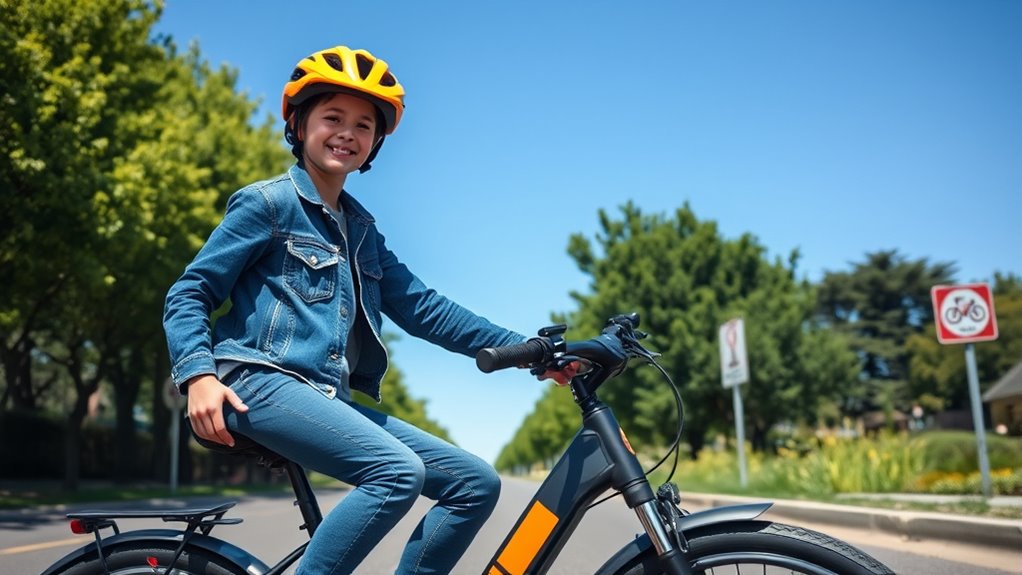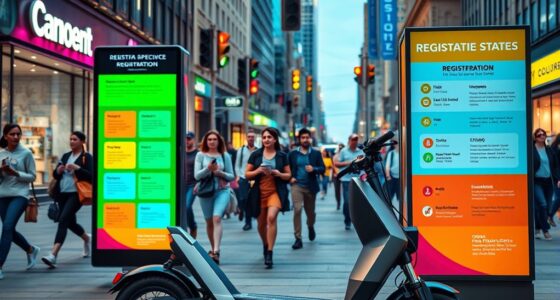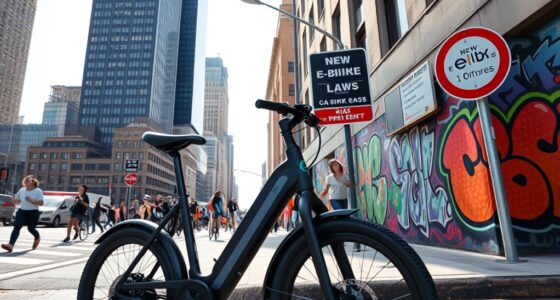In Oregon 2025, you must be at least 16 to ride a Class 2 or 3 e-bike on public roads and trails, but there are no age restrictions for Class 1 bikes. Helmet rules require anyone under 18 to wear a helmet at all times, while it’s strongly recommended for adults for safety. Staying compliant keeps you protected and legal. If you want to understand how these rules apply to your riding habits, there’s more to uncover.
Key Takeaways
- Riders under 16 are generally prohibited from riding e-bikes on public roads and trails in Oregon.
- Helmet use is mandatory for all riders under 18, regardless of e-bike class.
- E-bike classification determines where and how riders can safely and legally operate.
- Age restrictions are stricter for Class 2 and 3 e-bikes to ensure minor safety.
- Proper helmet use and adherence to age limits promote safe and legal e-bike riding in Oregon.

If you’re planning to ride an e-bike in Oregon, it’s important to understand the state’s specific laws and regulations. These rules are designed to ensure your safety and the safety of others on the road or trail. One of the most critical aspects is bike safety, which involves knowing how to operate your e-bike responsibly and legally. The state classifies e-bikes based on their motor power and speed capabilities, which directly ties into motor regulations. Recognizing which class your e-bike falls into helps you stay compliant and avoid potential fines or legal issues.
In Oregon, e-bikes are generally categorized into three classes. Class 1 e-bikes have a motor that assists only when you’re pedaling and stops assisting at 20 mph. Class 2 e-bikes have a throttle and can reach up to 20 mph without pedaling. Class 3 e-bikes also assist only when pedaling but can go up to 28 mph. These classifications influence where you can ride and what safety gear you need to wear. For example, Class 3 bikes often require riders to wear helmets and may have restrictions on riding on certain bike paths or sidewalks. Understanding these distinctions is crucial for maintaining proper bike safety and adhering to motor regulations.
Age limits are another important consideration. In Oregon, children under 16 are generally prohibited from riding e-bikes on public roads or trails, especially for Classes 2 and 3. This age restriction aims to protect younger riders from potential accidents and to ensure they’re mature enough to handle the bike responsibly. If you’re a parent or guardian, you should be aware of these restrictions to keep your kids safe and compliant with the law. Additionally, some local jurisdictions might have specific rules regarding age and e-bike use, so it’s smart to check the regulations in your area.
Wearing a helmet is mandatory for all riders under 18, regardless of e-bike class. This rule emphasizes bike safety and helps prevent head injuries in case of falls or collisions. For adult riders, helmet use is strongly recommended, even if not legally required, as it *substantially* reduces injury risk. Proper helmet use, along with obeying motor regulations related to speed and operation, ensures you’re riding responsibly and safely. Being aware of these rules not only helps you avoid penalties but also promotes a culture of safety for everyone sharing the road or trail.
To further promote safety, understanding Cultural Intelligence and respecting local customs and regulations can help foster positive interactions with fellow riders and pedestrians.
Frequently Asked Questions
Are E-Bikes Allowed on Public Transportation in Oregon?
Yes, you can take your e-bike on public transportation in Oregon, but you need to follow specific restrictions. Public transit restrictions vary, so check with your transit provider beforehand. You’ll also need to comply with e-bike storage regulations, which often require folding e-bikes or designated areas for non-folding bikes. Ensuring you adhere to these rules makes your trip smoother and helps you avoid penalties.
What Are Specific Penalties for Violating E-Bike Laws?
If you violate e-bike laws in Oregon, you face penalties enforcement that can include fines, citations, or even criminal charges for serious offenses. The legal consequences depend on the violation, such as riding without a helmet or exceeding age limits. Law enforcement actively enforces these rules, so you should follow all regulations to avoid penalties. Staying informed helps you ride legally and prevents costly consequences down the line.
Do E-Bike Laws Differ Between Cities in Oregon?
You’ll find that e-bike laws do differ between Oregon cities due to local enforcement and municipal regulations. Some cities may require additional safety gear, restrict where you can ride, or impose specific age limits beyond state law. It’s important to check each city’s regulations before riding, as local authorities can enforce rules that go beyond state requirements. Staying informed helps you ride legally and safely across different Oregon communities.
Are E-Bike Licenses Required in Oregon?
Think of Oregon’s e-bike regulations as a modern Odyssey—you don’t need a license to ride an e-bike, except in specific cases. Licensing requirements generally don’t apply to most riders, and permit exemptions are common for those under certain age groups or riding on designated paths. Always check local rules, but for the most part, you can enjoy your ride without a license, just stay within the rules.
How Do E-Bike Laws Apply to Visitors From Other States?
As a visitor from another state, you must follow Oregon’s e-bike laws during interstate travel. These visitor regulations require you to comply with local age limits, helmet rules, and licensing requirements. Always carry your ID and proof of age, and familiarize yourself with Oregon’s specific e-bike classifications. Staying compliant ensures safe and legal riding, helping you enjoy your trip without legal issues.
Conclusion
So, now you know Oregon’s e-bike laws—age limits, helmet rules, and all that jazz. You’d think with such strict laws, e-biking would be a boring chore, right? Ironically, it’s actually more fun and safe. So, go ahead, hop on your e-bike, follow the rules, and enjoy the ride—because the only thing more exhilarating than a speedy e-bike is realizing you’re actually playing by the rules. Happy riding!









